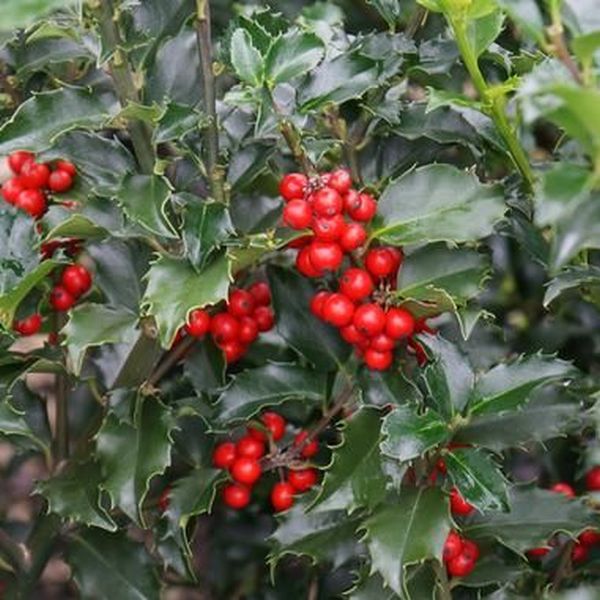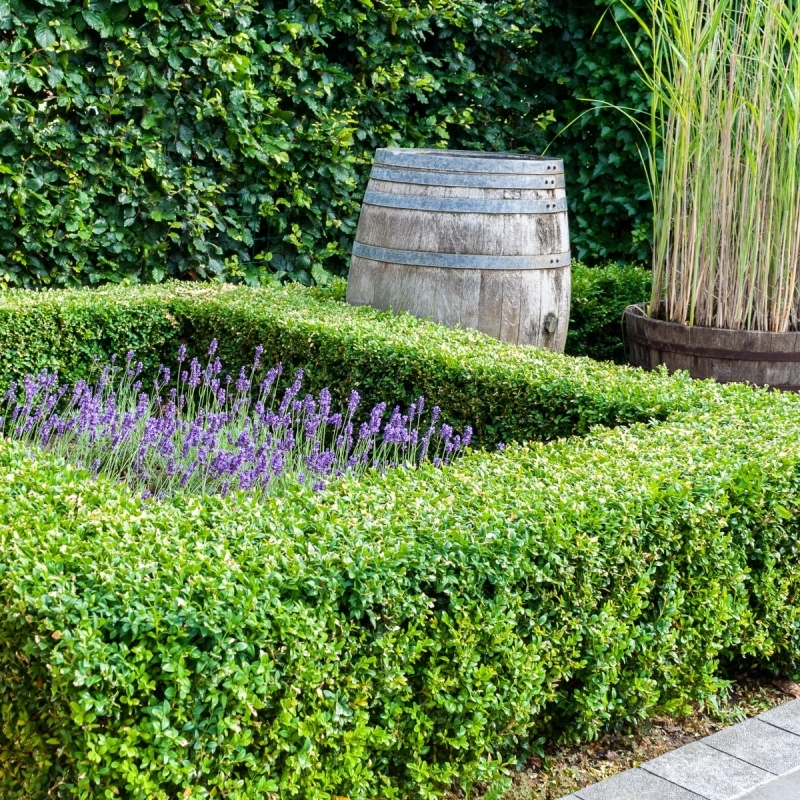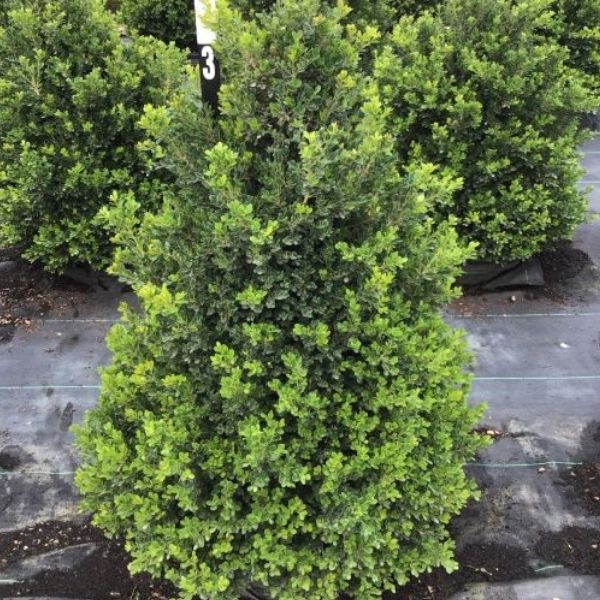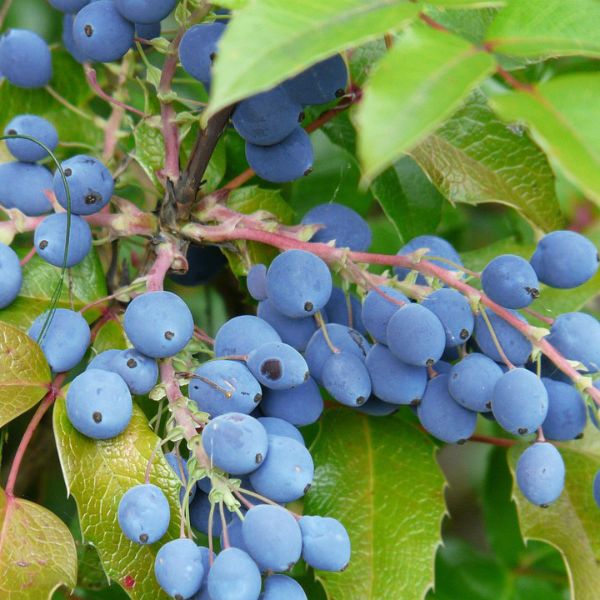
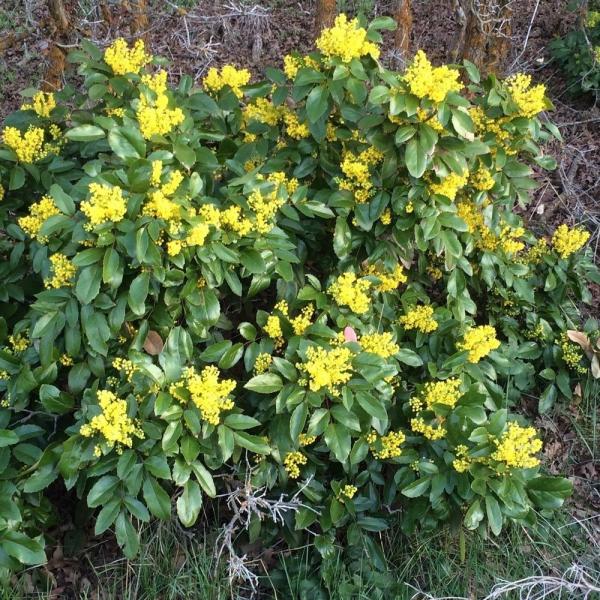
Oregon Grape Holly
Mahonia aquifolium
9 reviews
Oregon Grape Holly
Mahonia aquifolium
9 reviews
- Evergreen foliage provides year-round interest
- Tolerant of various soil types and conditions
- Attracts pollinators with its bright yellow flowers
- Recommended by landscape designers for optimal fit in real yards
$112.00
$160.00
30% Off
- Ships to 43215 in 3 to 7 days
- Free Shipping Over $150
- Plant Arrival Guarantee
- In Stock
- Free Plant Consult
$200 - Landscape-Approved: Every Plant We Sell Comes With Design Expertise Behind It
- 3.5 Gallon
- 1 Gallon
Not just beautiful - intentionally selected by ShrubHub's 3D landscape design team to fit real-world spaces and maximize yard potential.
Why Oregon Grape Holly?
Oregon grape holly (Mahonia aquifolium) is a hardy evergreen shrub native to North America. It is known for its attractive yellow flowers and dark purple berries. Historically, the plant has been used for medicinal purposes, including to treat skin conditions and digestive issues. It is also a popular landscaping plant due to its low maintenance requirements and ornamental qualities. Additionally, the plant serves as an important food source for birds and other wildlife.
People who loved this plant also bought
Sunlight
Oregon Grape Holly (Mahonia aquifolium) thrives in partial shade to full sun, but it prefers more shade than direct sunlight. It can tolerate a wide range of light conditions, making it a versatile and adaptable plant for various gardening situations.
Watering
Oregon Grape Holly has low to moderate watering requirements. It is drought-tolerant once established but benefits from occasional deep watering during hot and dry periods. Ensuring the soil remains moist but not waterlogged is crucial for its optimal grow
Fertilizing
Oregon Grape Holly (Mahonia aquifolium) prefers a balanced fertilizer with an NPK ratio of 10-10-10 or 14-14-14. Apply the fertilizer in early spring and late fall to provide essential nutrients for healthy growth. Avoid over-fertilization, as it may lead
Oregon Grape Holly, also known as Mahonia aquifolium, is a broadleaf evergreen shrub, native to Western North America. They naturally grow under the high canopies of the pine and fir forests of the Western States. Also, the state flower of Oregon, Oregon Grape Holly is known for its abundance of colors across all four seasons.
In spring, the branches of Oregon Grape Holly bear long, hanging clusters of lightly fragrant, bright yellow flowers which give way to dark, blueberries in summer. The glossy dark green evergreen leaves are sharply toothed and have texture interest as well as color interest. When they first emerge, they are red and gradually turn into a shiny green hue, and with fall, they become a brilliant display of burgundy.
The edible berries are often used to make jams and in other recipes. And the inner bark of Oregon Grape Holly is a source of yellow dye. But even without those two uses, Oregon Grape Holly is a wonderful evergreen shrub that makes a beautiful statement in any landscape.
Oregon Grape Holly reaches a mature size between 3 and 10 feet tall, with 2-5 feet wide. It's low maintenance and caring for it is quite simple. Oregon Grape Holly is hardy in USDA Hardiness Zones 5-9.
It prefers well-drained soil in a location in the full sun to partial shade, depending on the harshness of the sun in your area. Oregon Grape Holly is drought tolerant and only needs watering during extended dry spells. Prune to remove suckers and seedlings as necessary to restrict them to the desired areas.
Oregon Grape Holly is an excellent choice for use as a specimen plant, a hedge, or as part of a mixed border, among many other uses. Order yours from Shrubhub today to get the healthiest shrub in its best state!
Plant Information:
| Botanical Name: | Mahonia aquifolium |
| USDA Zones: | 5 - 9 |
| Water: | Moderate |
| Exposure: | Full Shade |
| Soil Needs: | Well Drained |
| Mature Height: | 3 - 6 feet |
| Mature Spread: | 3 - 5 feet |






Pollination Info
Oregon Grape Holly, also known as Mahonia aquifolium, is a popular evergreen shrub in the Pacific Northwest region of North America. It is an important source of nectar for many pollinators, including bees, butterflies, and hummingbirds. The plant produces distinctive bright yellow flowers in late winter or early spring.
Pollination Process
Oregon Grape Holly flowers are hermaphroditic, which means they have both male and female reproductive structures. However, the plant does not self-pollinate, so it relies on external pollination. Pollinators are attracted to the bright yellow flowers, which are rich in nectar and pollen.
When a pollinator lands on a flower, it brushes against the anthers, which are the male reproductive structures. This causes the release of pollen, which sticks to the pollinator's body. As the pollinator moves from flower to flower, it transfers the pollen to the stigma, which is the female reproductive structure. The pollen then travels down the style to fertilize the ovules and produce seeds.
Importance of Pollination
Pollination is crucial for the reproduction and survival of Oregon Grape Holly. Without pollinators, the plants would not produce seeds or fruit. This would have a cascading effect on the local ecosystem, as many animals rely on the berries for food.
Furthermore, Oregon Grape Holly is an important medicinal plant and has been used for centuries by indigenous peoples for its therapeutic properties. The plant contains berberine, a compound that has been shown to have antibacterial, anti-inflammatory, and antidiabetic effects. Without pollinators, the plant would not be able to produce seeds or reproduce, which would jeopardize its long-term survival.
FAQ
Oregon Grape Holly (Mahonia aquifolium) FAQ
What is Oregon Grape Holly?
Oregon Grape Holly (Mahonia aquifolium) is a species of flowering plant in the Berberidaceae family. It is native to western North America and has clusters of yellow flowers that bloom in early spring.
How tall does Oregon Grape Holly grow?
Oregon Grape Holly typically grows to a height of 3-6 feet (0.9-1.8 meters) and a spread of 2-5 feet (0.6-1.5 meters).
What are the growing conditions for Oregon Grape Holly?
Oregon Grape Holly prefers well-drained soil and partial shade to full sun. It can tolerate a wide range of soil types, including clay and sand. It is drought-tolerant but benefits from regular watering during the growing season.
Is Oregon Grape Holly evergreen?
Yes, Oregon Grape Holly is an evergreen shrub that retains its foliage year-round.
What are the medicinal uses of Oregon Grape Holly?
Oregon Grape Holly has been traditionally used in herbal medicine to treat a range of ailments, including digestive issues, skin conditions, and respiratory infections. It contains a compound called berberine, which has antimicrobial and anti-inflammatory properties.
Can Oregon Grape Holly be propagated from cuttings?
Yes, Oregon Grape Holly can be propagated from cuttings taken in early summer or fall. Rooting hormone can be used to increase the success rate.
What pests and diseases affect Oregon Grape Holly?
Oregon Grape Holly is relatively resistant to pests and diseases, but it can be susceptible to root rot in wet soil conditions. Scale insects and aphids can also occasionally infest the plant.
Can Oregon Grape Holly be used as a hedge?
Yes, Oregon Grape Holly can be used as a hedge or screen due to its dense growth habit and thorny foliage, which can deter intruders.
When is the best time to prune Oregon Grape Holly?
Oregon Grape Holly is best pruned in late winter or early spring before new growth begins. This will help maintain its shape and stimulate new growth.
Planting & Care
Planting Oregon Grape Holly (Mahonia aquifolium)
- Choose a planting site with well-draining soil and access to partial shade or sunlight.
- Dig a hole that is twice as wide and deep as the root ball of the plant.
- Loosen the soil at the bottom of the hole with a garden fork.
- Place the root ball into the hole and backfill with soil, gently packing it down as you go.
- Water the plant well and spread a layer of mulch around the base of the plant to retain moisture and suppress weeds.
Caring for Oregon Grape Holly (Mahonia aquifolium)
- Water the plant deeply once a week during the growing season and less frequently during the winter.
- Fertilize the plant in early spring with a balanced fertilizer, following package instructions.
- Prune the plant in late winter or early spring, removing any dead or damaged branches and shaping the plant as desired.
- Protect the plant from strong winds and heavy snow by tying it to a support or wrapping it in burlap.
- Keep an eye out for signs of pests or diseases, such as yellowing leaves or spotted foliage, and treat as necessary.
Check Out These Verified Customer Reviews:
Customer Reviews
4.4 out of 5 based on 9 reviews
Thank you! Your review has been submitted.
Great customer service, quick response.
Healthy plant, just as described.
Beautiful foliage, vibrant colors.
Item has been added to your cart.





